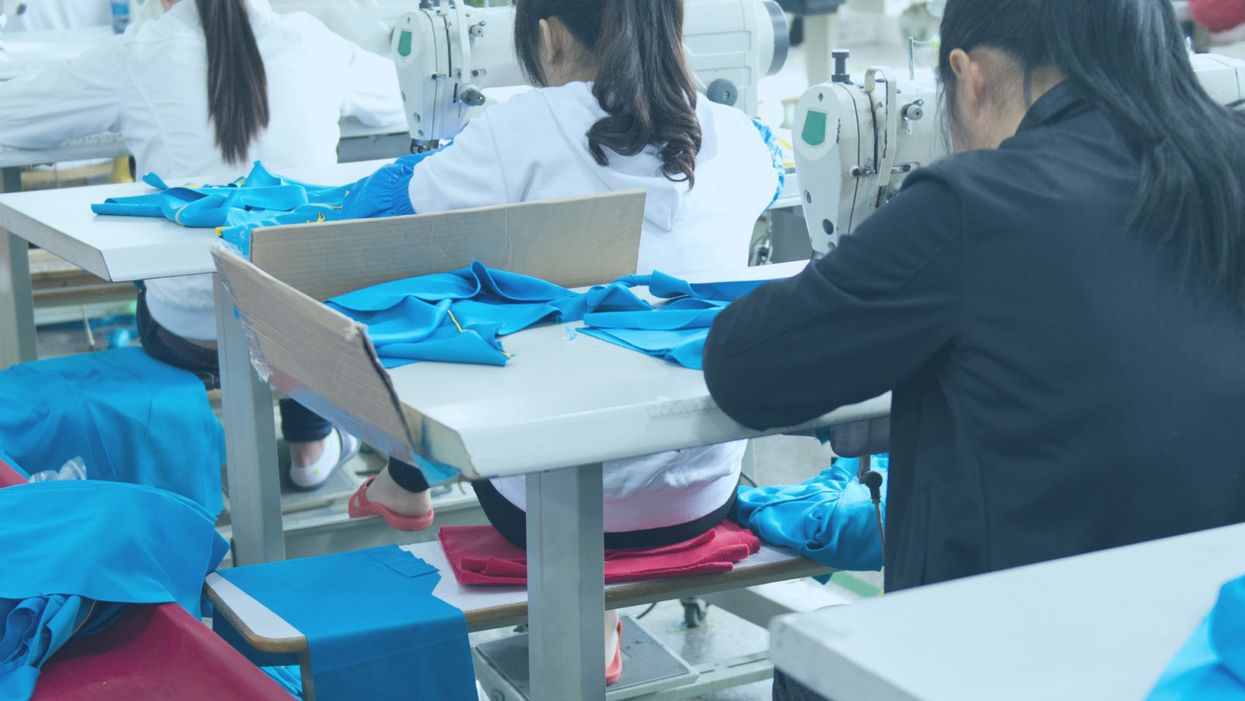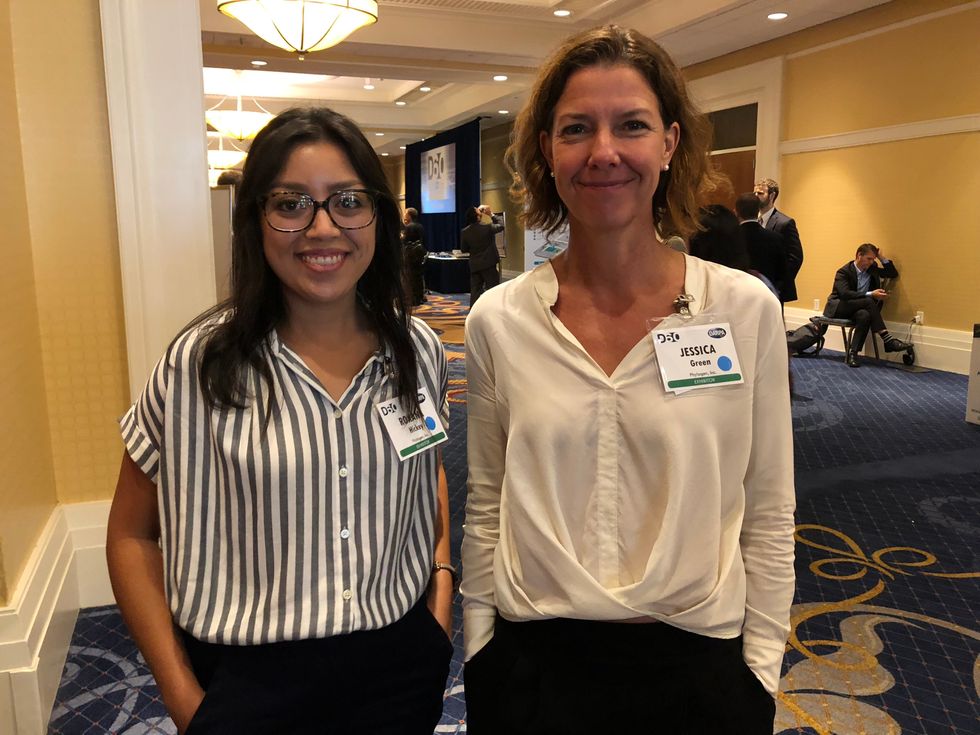This Startup Uses Dust to Fight Sweatshops
Kira Peikoff was the editor-in-chief of Leaps.org from 2017 to 2021. As a journalist, her work has appeared in The New York Times, Newsweek, Nautilus, Popular Mechanics, The New York Academy of Sciences, and other outlets. She is also the author of four suspense novels that explore controversial issues arising from scientific innovation: Living Proof, No Time to Die, Die Again Tomorrow, and Mother Knows Best. Peikoff holds a B.A. in Journalism from New York University and an M.S. in Bioethics from Columbia University. She lives in New Jersey with her husband and two young sons. Follow her on Twitter @KiraPeikoff.

Workers at an industrial textile factory.
"Dust thou art, and unto dust shalt thou return." Whoever wrote that famous line probably didn't realize that dust actually contains a secret weapon.
"We have developed the capability to turn dust into data that can be used to trace problems in the supply chain."
Far from being a collection of mere inanimate particles, dust is now recognized as a powerful tool filled with living sensors. Studying those sensors can reveal an object's location history, which can help brands fight unethical manufacturing.
"We have developed the capability to turn dust into data that can be used to trace problems in the supply chain," explains Jessica Green, the CEO of Phylagen, a San-Francisco-based company that she co-founded in 2014.
So how does the technology work?
Dust gathers everywhere—on our bodies, on objects—and that dust contains microbes like bacteria and viruses. Just as we humans have our own unique microbiomes, research has shown that physical locations have their own identifiable patterns of microbes as well. Visiting a place means you may pick up its microbial fingerprint in the dust that settles on you. The DNA of those microbes can later be sequenced in a lab and matched back to the place of origin.
"Your environment is constantly imprinted on you and vice versa," says Justin Gallivan, the director of the Biotechnology Office at DARPA, the research and defense arm of the Pentagon, which is funding Phylagen. "If we have a microbial map of the world," he posits, "can we infer an object's transit history?"
So far, Phylagen has shown that it's possible to identify where a ship came from based on the unique microbial populations it picked up at different naval ports. In another experiment, the sampling technology allowed researchers to determine where a person had walked within 1 kilometer in San Francisco, because of the microbes picked up by their shoes.
One application of this technology is to help companies that make products abroad. Such companies are very interested in determining exactly where their products are coming from, especially if foreign subcontractors are involved.
"In retail and apparel, often the facilities performing the subcontracting are not up to the same code that the brands require their suppliers to be, so there could be poor working conditions," says Roxana Hickey, a data scientist at Phylagen. "A supplier might use a subcontractor to save on the bottom line, but unethical practices are very damaging to the brand."
Before this technology was developed, brands sometimes faced a challenge figuring out what was going on in their supply chain. But now a product can be tested upon arrival in the States; its microbial signature can theoretically be analyzed and matched against a reference database to help determine if its DNA pattern matches that of the place where the product was purported to have been made.
Phylagen declined to elaborate further about how their process works, such as how they are building a database of reference samples, and how consistent a microbial population remains across a given location.
As the technology grows more robust, though, one could imagine numerous other applications, like in police work and forensics. But today, Phylagen is solely focused on helping commercial entities bring greater transparency to their operations so they can root out unauthorized subcontracting.
Then those unethical suppliers can – shall we say – bite the dust.
Kira Peikoff was the editor-in-chief of Leaps.org from 2017 to 2021. As a journalist, her work has appeared in The New York Times, Newsweek, Nautilus, Popular Mechanics, The New York Academy of Sciences, and other outlets. She is also the author of four suspense novels that explore controversial issues arising from scientific innovation: Living Proof, No Time to Die, Die Again Tomorrow, and Mother Knows Best. Peikoff holds a B.A. in Journalism from New York University and an M.S. in Bioethics from Columbia University. She lives in New Jersey with her husband and two young sons. Follow her on Twitter @KiraPeikoff.
A woman receives a mammogram, which can detect the presence of tumors in a patient's breast.
When a patient is diagnosed with early-stage breast cancer, having surgery to remove the tumor is considered the standard of care. But what happens when a patient can’t have surgery?
Whether it’s due to high blood pressure, advanced age, heart issues, or other reasons, some breast cancer patients don’t qualify for a lumpectomy—one of the most common treatment options for early-stage breast cancer. A lumpectomy surgically removes the tumor while keeping the patient’s breast intact, while a mastectomy removes the entire breast and nearby lymph nodes.
Fortunately, a new technique called cryoablation is now available for breast cancer patients who either aren’t candidates for surgery or don’t feel comfortable undergoing a surgical procedure. With cryoablation, doctors use an ultrasound or CT scan to locate any tumors inside the patient’s breast. They then insert small, needle-like probes into the patient's breast which create an “ice ball” that surrounds the tumor and kills the cancer cells.
Cryoablation has been used for decades to treat cancers of the kidneys and liver—but only in the past few years have doctors been able to use the procedure to treat breast cancer patients. And while clinical trials have shown that cryoablation works for tumors smaller than 1.5 centimeters, a recent clinical trial at Memorial Sloan Kettering Cancer Center in New York has shown that it can work for larger tumors, too.
In this study, doctors performed cryoablation on patients whose tumors were, on average, 2.5 centimeters. The cryoablation procedure lasted for about 30 minutes, and patients were able to go home on the same day following treatment. Doctors then followed up with the patients after 16 months. In the follow-up, doctors found the recurrence rate for tumors after using cryoablation was only 10 percent.
For patients who don’t qualify for surgery, radiation and hormonal therapy is typically used to treat tumors. However, said Yolanda Brice, M.D., an interventional radiologist at Memorial Sloan Kettering Cancer Center, “when treated with only radiation and hormonal therapy, the tumors will eventually return.” Cryotherapy, Brice said, could be a more effective way to treat cancer for patients who can’t have surgery.
“The fact that we only saw a 10 percent recurrence rate in our study is incredibly promising,” she said.
Urinary tract infections account for more than 8 million trips to the doctor each year.
Few things are more painful than a urinary tract infection (UTI). Common in men and women, these infections account for more than 8 million trips to the doctor each year and can cause an array of uncomfortable symptoms, from a burning feeling during urination to fever, vomiting, and chills. For an unlucky few, UTIs can be chronic—meaning that, despite treatment, they just keep coming back.
But new research, presented at the European Association of Urology (EAU) Congress in Paris this week, brings some hope to people who suffer from UTIs.
Clinicians from the Royal Berkshire Hospital presented the results of a long-term, nine-year clinical trial where 89 men and women who suffered from recurrent UTIs were given an oral vaccine called MV140, designed to prevent the infections. Every day for three months, the participants were given two sprays of the vaccine (flavored to taste like pineapple) and then followed over the course of nine years. Clinicians analyzed medical records and asked the study participants about symptoms to check whether any experienced UTIs or had any adverse reactions from taking the vaccine.
The results showed that across nine years, 48 of the participants (about 54%) remained completely infection-free. On average, the study participants remained infection free for 54.7 months—four and a half years.
“While we need to be pragmatic, this vaccine is a potential breakthrough in preventing UTIs and could offer a safe and effective alternative to conventional treatments,” said Gernot Bonita, Professor of Urology at the Alta Bro Medical Centre for Urology in Switzerland, who is also the EAU Chairman of Guidelines on Urological Infections.
The news comes as a relief not only for people who suffer chronic UTIs, but also to doctors who have seen an uptick in antibiotic-resistant UTIs in the past several years. Because UTIs usually require antibiotics, patients run the risk of developing a resistance to the antibiotics, making infections more difficult to treat. A preventative vaccine could mean less infections, less antibiotics, and less drug resistance overall.
“Many of our participants told us that having the vaccine restored their quality of life,” said Dr. Bob Yang, Consultant Urologist at the Royal Berkshire NHS Foundation Trust, who helped lead the research. “While we’re yet to look at the effect of this vaccine in different patient groups, this follow-up data suggests it could be a game-changer for UTI prevention if it’s offered widely, reducing the need for antibiotic treatments.”


